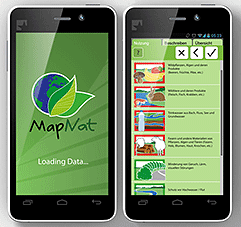News
Post-doctoral scientist position is open for the project "Towards an integrated prediction of Land & Sea Responses to global change in the Mediterranean Basin" (LaSeR-Med), which focusses on integrated socio-ecological modelling. The duration of the contract is initially one year, with a possible extension for a second year, depending on the initial results. The post-doc will be based within the Mediterranean Institute of marine and terrestrial Biodiversity and Ecology (IMBE) in Aix-en-Provence, France. The project is part of the Labex OT-Med (http://www.otmed.fr/).
Applicants should hold a doctoral degree in physics, chemistry, microbiology, geosciences, environmental sciences or a related field of science. They should be familiar with modelling biogeochemical interactions between ecosystems and capable to further develop existing numerical ecosystem models. Programming skills (C) and modelling experience are therefore mandatory. Knowledge of R and of Unix/Linux environment will be an advantage. The candidate should have good written and oral communication skills. For work, good skills in the English language will be essential.
The project:
Terrestrial and marine ecosystems are connected through groundwater, river discharge and nutrient outflows (especially N and P). River catchments in the Mediterranean are N-intensive regions, mostly due to intensive agriculture in the North and to crop N2 fixation or food & feed import in the South. The fraction of nutrient reaching the sea constitutes significant anthropogenic forcing of many marine biological processes. For simulating the dynamics of the first levels of the marine food web (from nutrients to jellyfishes), the ocean biogeochemical model, Eco3M-MED, used and developed by the Mediterranean Institute of Oceanography (MIO) within OT-Med, currently uses N and P measurements at river mouths, e.g. for the Rhône.
Your application:
Applications should contain a suitable motivation letter describing your anticipated role in the project, a CV, a list of scientific publications and the names of at least two scientists that can be contacted for references. They must be sent to Ms. Gabriela Boéri (gabriela.boeri@imbe.fr). Please prepare your application as a single file in pdf-format.
Questions about the project or the position can be directed to Dr. Alberte Bondeau (alberte.bondeau@imbe.fr). The position will be filled as soon as a suitable candidate has been found – work should start soon after that date. The salary and contract conditions will be determined according to standards set by Aix-Marseille University – questions in this regard can be directed to Sophie Pekar (pekar@otmed.fr).
Assessments of ecosystem services (ES), aiming at informing decisions on land management, are increasing in number around the globe, but only in a few cases recommendations are then applied by decision-makers in real life. In a new paper published in the journal Ecology and Society a team of researchers aims to bridge the gap between scientific research and policy needs, by providing a new step-by-step problem-oriented approach for informing land-use decisions.
Often ES assessments are found to fall short in targeting information needs by decision makers. To improve their applicability in practice, the research team suggests a problem-oriented approach, putting the real-life needs and issues faced by stakeholders at the core of an ES assessment.
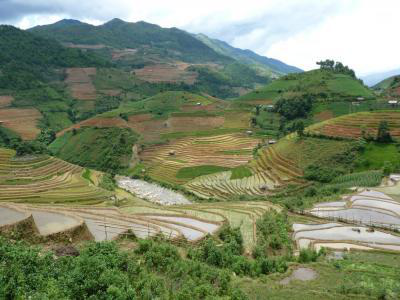
This picture shows irrigated rice fields in the Sapa region, Vietnam; Credit: Pavel Stoev
The scientists compared existing ES assessments concepts with focus on informing land use decisions, identifying opportunities for enhancing the relevance of ES assessments for decision making. Building on extensive experience of four projects in Brazil, China, Madagascar, and Vietnam, they developed a step-wise approach for better focussing ES assessments on the information needs in land use decisions, throughout the decision process:
-
Scoping phase (A): structuring ES information according to land use problems identified by stakeholders,
-
Assessment phase (B): collecting context-specific ES information as needed by decision makers, and assessing relevant management options,
-
Implementation phase (C): Synthesising, integrating and presenting information for decision support.
The development of each of them is broken down into several steps to provide an easy to follow workplan oriented towards maximum relevance for stakeholders.
Achieving a shared understanding of the role of ES within the social-ecological context can already be beneficial for the decision-making process. ES assessments are learning processes within which the design is refined and re-adjusted in the course of the assessment process and in response to newly acquired knowledge.
"To paraphrase Albert Einstein, assessments should be as simple as possible, but no simpler. We recognize that stepwise approaches are a simplification of the process required to fully understand the complexities involved in social-ecological systems." comments the lead author Johannes Förster. "However, our approach is meant to provide pragmatic guidance for making ES assessments more policy-relevant by focusing the design of assessments on particular land-use problems, stakeholder priorities, and information needs to explore options for more sustainable land management."
###
Additional information:
This paper is partly based on and supported by the LEGATO project. LEGATO stands for 'Land-use intensity and Ecological Engineering - Assessment Tools for risks and Opportunities in irrigated rice based production systems' and aims to advance long-term sustainable development of irrigated rice fields, against risks arising from multiple aspects of global change. The overall objective is the elaboration and testing of generally applicable principles within the frame of ecological engineering - an emerging discipline, concerned with design, monitoring and construction of ecosystems.
Original Source:
Förster, J., J. Barkmann, R. Fricke, S. Hotes, M. Kleyer, S. Kobbe, D. Kübler, C. Rumbaur, M. Siegmund-Schultze, R. Seppelt, J. Settele, J. H. Spangenberg, V. Tekken, T. Václavík, and H. Wittmer. 2015. Assessing ecosystem services for informing land-use decisions: a problem-oriented approach. Ecology and Society 20(3):31. http://dx.
Like the European Commission in their Biodiversity Strategy from 2011, now also the USA government recognises that nature provides vital contributions to economic and social well-being and publsihes a memorandum that provides direction to agencies on incorporating ecosystem services into Federal planning and decision making.
The memorandum directs agencies to develop and institutionalize policies that promote consideration of ecosystem services, where appropriate and practicable, in planning, investment, and regulatory contexts. It also establishes a process for the Federal government to develop a more detailed guidance on integrating ecosystem-service assessments into relevant programs and projects to help maintain ecosystem and community resilience, sustainable use of natural resources, and the recreational value of the Nation’s unique landscapes.
This memorandum complements Ecosystem-Service Assessment: Research Needs for Coastal Green Infrastructure, a report released by the Administration in August that outlines Federal research priorities to inform the integration of coastal green infrastructure and ecosystem services considerations into planning and decision-making. Read more.
The Call for Papers for a new Special Issue - Putting Ecosystem Services (ES) into practice. Assessment tools and indicators for land management - is now announced. The issue planned to be published in the Ecosystem Services Journal will aim to present novel approaches to implement ecosystem service frameworks putting them into practice towards sustainable land management.
This could be by coupling ecosystem services with land use change models, stakeholder approaches to introduce newly developed tools and to address user needs and requests regarding thefuture course of assessment tools and development of indicators. Specific application of the ES framework within different decision support systems, from planning, impact assessment, project implementation and policy making are also welcomed. The application of these tools/indicators will be ideally discussed in specific case studies. Discussion could be focused on the currently addressed issues as well as technical and methodological challenges, helping in putting the ES framework into practical applications for land management.
Important dates
-
Final Submission deadline: 01 of March 2016
-
Final publication decisions (after peer review): 01 of October 2016
-
Expected publication date of the Special Issue: 01 of February 2017
Contact
For further questions please feel free to contact: Luis Inostroza, Inostroza@technotope.org or Hannes
König, hkoenig@zalf.de
For more information, please see the official call PDF.
ecoSERVICES is seeking a new host institution to establish its international project office from 2016. Expressions of interest will be examined with the scientific steering committee on the week of 30 November 2015.
Currently hosted at the Institut Méditerranéen de Biodiversité et d’Ecologie (IMBE) in France, ecoSERVICES is seeking a new host for its international project office from 2016
The ideal host institution works on scientific issues related to biodiversity, ecosystem services and human well-being, at various scales from local or national to global; and meets a few practical specifications via direct funding or in-kind support for establishment of a fully operational office.
Expressions of interest need to be sent to Karine Payet-Lebourges by email with subject "ecoSERVICES IPO – Offer".
Applications will be examined with the scientific steering committee on the week of 30 November 2015.
More information here.
The first ESMERALDA Stakeholder Workshop took place from 13 to 16 October 2015 in Riga, Latvia, as the first of a series of events planned to enhance the project collaboration with stakeholders. The event brought together project partners and stakeholders to discuss the state and gaps of ecosystem service mapping and assessment activities in their countries, and the ways ESMERALDA outputs can feed into their work to achieve Action 5 of the EU Biodiversity Strategy.

View from Riga, Latvia where the workshop tool place. Credit: I. Kuzmova
The event, organised by the ESMERALDA partners Finnish Environment Institute (SYKE) and the Baltic Environmental Forum (BEF), was attended by over 70 participants - policy and decision makers, as well as other professionals working in the field of ecosystem services, from across EU member states.
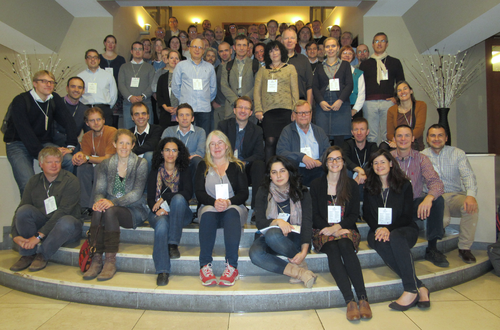
Group photo, more that 70 participants from across EU Member states. Credit: I. Kuzmova
ESMERALDA aims at supporting national stakeholders in order to fulfil their tasks within the EU Biodiversity Strategy 2020. Target 2 Action 5 of the strategy asks all EU member states to map and assess ecosystems and the services they provide within their national territories. ESMERALDA further aims to develop a flexible methodology for mapping of ecosystems and ecosystem services to provide building blocks for pan-European, regional and local assessments as contributions to the EU Biodiversity Strategy.
ESMERALDA will provide:
-
a set of practical policy recommendations, among others based on thematic case studies carried out in the project;
-
a set of recommendations for the future development and implementation of related policies;
-
practical guidance, data and tools for using biodiversity and ecosystem-related data in other policies.
Stakeholder engagement is therefore key for ESMERALDA in order to identify needs within the individual member states and to provide the right support and coordination for related activities, to fulfil requirements of policy making and to integrate them into the project research.
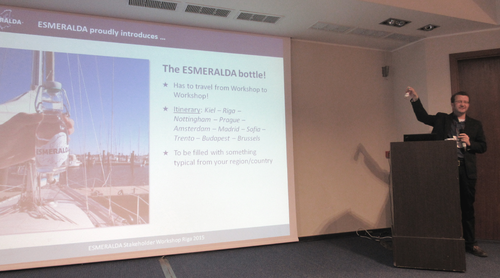
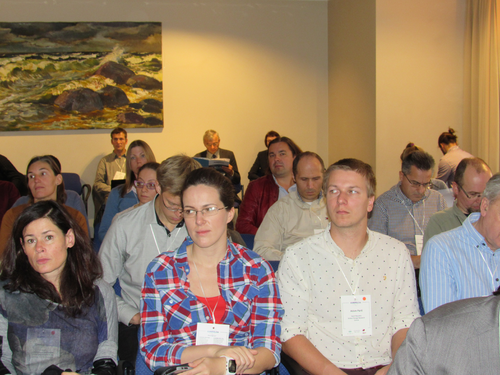
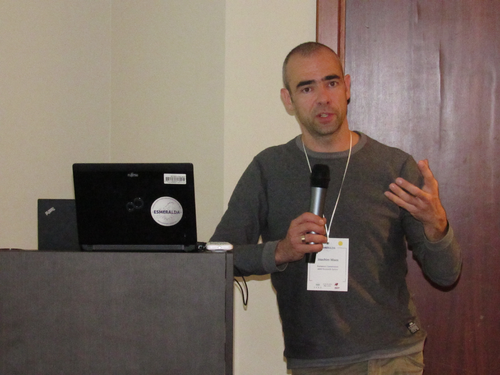
Top: Project coordinator B. Burkhard passes the ESMERALDA Workshop symbol 'the ESMERALDA Bottle' to the local organizers; Left: Participants at the meeting; Right: Joachim Maes presenting during the workshop. Credit: I. Kuzmova
Presentations form the meeting:
General overview of ESMERALDA activities_B.Burkhard
Welcome words by the host Baltic Environmental Forum Latvia_K.Veidemane
Stakeholder network and mapping and assessment activities _L.Kopperoinen
Update biodiversity strategy and MAES_J.Maes
Final discussion on recommendations for how to get forward_B.Burkhard
September was an eventful month for ESMERALDA. In the middle of the month, the project held a series of key meetings to set the foundation for future collaboration not only within the project itself, but also with key stakeholders and related projects.
On 15 Sep, in Brussels, ESMERALDA had the fifth of its regular Executive Board meetings, designed to bring together project partners and set objectives for the next period. On the next day, 16 Sep, followed the first Science-Policy-Society Advisory Board (SPSAB) meeting, as well as the first of a series of meetings designed to bring ESMERALDA in the same room with related projects, representatives from the European Commission and relevant initiatives to discuss future axes of collaboration.
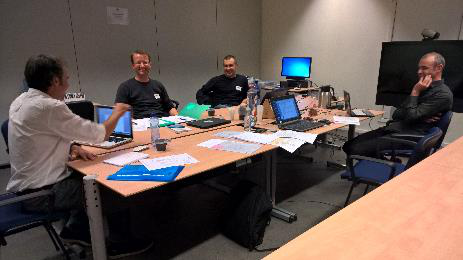
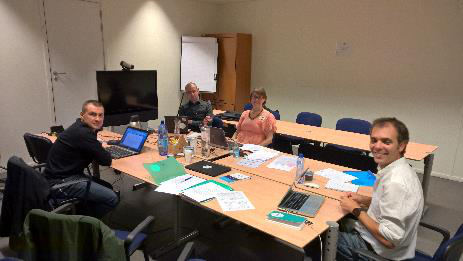
Images from the 5th Executive Board meeting in Brussels. Credit: B. Burkhard
While the routine Executive Board meeting was targeted at keeping in check past tasks and set a working plan for the next couple of months, the SPSAB meeting on the next day was a first of its kind for the project. The role of the multidisciplinary SPSAB is to advise the ESMERALDA Executive Board on the project performance, progress and on international developments in the scientific field. The Board consists of international key science and policy professionals working in relevant fields, and acts as a peer-review panel with respect to new project proposals, the research results as a whole and the training and communication activities.
The 16 Sep was a date marked by another important project workshop where ESMERALDA met key European projects and initiatives. This was a first of a series of workshops aimed to develop ESMERALDA communication with relevant initiatives to foster future collaboration and visibility of results.
<blockquote class="twitter-tweet" lang="en" align="center>
@ESMERALDA_H2020 meets with http://t.co/ZDP9A9BLpq and http://t.co/gl6oZtBM3y to see how #MAES results can feed these information systems
— Joachim Maes (@MaesJoachim) September 16, 2015
During this first workshop ESMERALDA met with representatives from the OPPLA and BISE online platforms, designed to collect information and foster collaboration between EU projects in the spheres of Biodiversity, Ecosystem services, and Ecology. More information about the two platforms and other relevant projects and initiatives is available here.
On 17 Sep, several project partners participated in the 10th Meeting of the EU Working Group on Mapping and Assessment of Ecosystems and their Services (MAES). MAES is highly relevant and ESMERALDA has been designed to significantly support the Working Group’s activities. The MAES meeting was followed by a meeting on how MAES can support the deployment of Green Infrastructure in Europe on 18 Sep in Brussels.
The 8th World Conference of the Ecosystem Services Partnership (ESP) will be held in Stellenbosch, South Africa, 9-13 November 2015. In addition to 37 sessions organised by the ESP working groups and key-partners (e.g. UNEP, UNCCD, TEEB, GIZ, Natural Capital Coalition and many others) on a wide range of topics, the conference will focus on the use of ecosystem services "for Nature, People and Prosperity", including the role in Conservation, Livelihoods and Business, which will be introduced, and discussed by well-known keynote speakers.
The conference will be held at Spier Conference Centre & Wine Farm near Cape Town.
For information on the conference: http://www.espconference.org
For information on ESP: www.es-partnership.org
A new study featured in Science for Environment Policy (SEP) - "Phosphorus removal performance of a large-scale constructed treatment wetland receiving eutrophic lake water.", published in Ecological Engineering, looks at the benefits of constructed wetland ecosystem services.
The economic benefits of the ecosystem services provided by constructed wetlands far outweigh the costs of maintaining them, the new research has confirmed. Analysis of a wetland that treats the third largest lake in Florida, US, shows that it provides ecosystem services worth $1.79 (€1.64) million per year, against costs of less than half that figure.
Eutrophication, an excess of nutrients within water, has become a significant environmental problem. Nitrogen and phosphorus pollution enters waterways as a result of run-off of agricultural fertilisers, and can be damaging for aquatic wildlife. Wetlands, which filter pollutants from water before they reach lakes, streams and oceans, can mitigate this problem. Although they occur naturally, artificial wetlands can also be constructed, and are now in use all over the world.
This study assessed the effectiveness of a large constructed wetland in the US. The researchers assessed the ability of the marsh flow-way in Florida, which filters Lake Apopka — the third largest lake in the state — to remove phosphorus from lake water.
Using estimates provided by ecological economics, which give monetary value to ecosystem services such as water pollution control, the researchers were able to estimate that the marsh flow-way provides a value of $1.79 (€1.64) million per year, many times greater than its annual running costs.
However, the researchers say that this is a crude estimate, which should be used to give an idea of the benefits of a wetland approach rather than a precise valuation.
As well quantifying costs and performance, the researchers also considered the ecological benefits of the wetland to assess management of the flow-way. The authors recommend that, when assessing system performance, wetland managers use a cost benefit approach that considers ecosystem services. They say this could lead to more effective and more sustainable water resource management.
Read more in the SEP brief.
Original Source:
Dunne, E., Coveney, M., Hoge, V., Conrow, R., Naleway, R., Lowe, E., Battoe, L. & Wang, Y. (2015). Phosphorus removal performance of a large-scale constructed treatment wetland receiving eutrophic lake water. Ecological Engineering 79, pp.132-142. DOI: 10.1016/j.ecoleng.2015.02.003
The latest issue of Science for Environment Policy (SEP) fetures a new study looking at Mediterranean countries and their use of natural resources - "Physical limits to resource access and utilisation and their economic implications in Mediterranean", published in Environmental Science & Policy.
In the Mediterranean region the demand for natural resources and ecological services is two and half times greater than ecosystems’ capacity to provide them, recent research has found. To meet this demand, countries rely on imports, exposing themselves to price volatility and potential resource shortages. According to the authors, a 10% increase in global prices would particularly impact vulnerable countries such as Jordan, which would see its trade balance worsening by 2.4% of its gross domestic product.
The recent study investigated consumption needs for natural resources and ecological services in the Mediterranean countries and their ability to satisfy such needs with domestic ecological assets. The methodology is based on Ecological Footprint accounting, which is a simple accounting tool used to summarise ecological resources and services contained in products made in, traded internationally, and consumed by a country. Resources include food and wood, while services include carbon dioxide locked in forests, which removes the gas from the atmosphere and helps to regulate climate.
The evidence provided shows the need for policymakers to recognise, measure and understand the interactions between ecological assets and economic performance in the Mediterranean area. The coexistence of limited bio-capacity and high footprint in the region, especially due to the carbon component (45%), might induce people in the countries to consider more sustainable consumption patterns. The researchers highlight the need to better manage natural resources and innovate for future wellbeing by, for example, encouraging new farming technology and coupling resource efficiency measures with considerations of the overall consumption levels.
Read more in the official SEP brief.
Original Source:
Galli, A., Halle, M. & Grunewald, N. (2015). Physical limits to resource access and utilisation and their economic implications in Mediterranean economies. Environmental Science & Policy 51: 125 – 136. DOI:10.1016/j.envsci.2015.04.002.
The Institute of Environmental Planning at the Leibniz University Hannover invites applications for a position as a Junior Researcher/PhD student – Landscape Planning and Ecology to be appointed October 1, 2015. The position is limited to 3 years. The extent of the position is equivalent to 50% of the standard working time.
Responsibilities and duties include carrying out research in the sub-project "Assessing and Valuing Cultural Ecosystem Services) in the Research Project "River-Ecosystem-Service-Index" (RESI) funded by the German Federal Ministry of Education and Research (BMBF). The candidate is expected to strive for further scientific qualification (PhD).
For more information, please see the official job offer here.
A new special issue "Ecosystem services: building informed policies to orient landscape dynamics" was recently pulished in the International Journal of Biodiversity Science, Ecosystem Services & Management as an outcome of the Symposia "Ecosystem Services: Building Informed Policies to orient Landscape Dynamics" and "Land system change impacts on European landscapes" at the 2013 IALE European Congress - Changing European Landscapes.
In reaction to the failure of traditional environmental management approaches grounded on the paradigm "control change in systems", Ecosystem Services (ES) have emerged as a novel way of understanding ecosystem and landscape dynamics, including change, interactions and flows between human and natural systems.
ES can be interpreted as the result of a process of knowledge building and design, which has to be set according to some variables, as follows: (i) domain: identification of the territorial and temporal area of assessment and its boundaries according to landscape characteristics; (ii) potential: identification and calculation of ecosystem functions that such area can provide; (iii) beneficiaries: the end-users who will profit of the ES; (iv) providers: individuals or agents, as farmers, who are in charge to support and manage ES provision.
ES are currently being investigated with respect to the potential and the capacity of ecosystems to supply them, but the link to decision-making processes is related to another phase. Thus, the aim of the Special Issue is to discuss opportunities and challenges of applying ES in the dialogue between science and policy. This is especially relevant with regard to the European Biodiversity Strategy and its 2020 targets and clear focus on ecosystem services. Hence, the interaction and dialogue between different disciplines play a special role in the Special Issue.
Access the special issue here: http://www.tandfonline.com/toc/tbsm21/11/3#.VcxXKflqXLB
The Department of Ecosystem Research at the Leibniz-Institute of Freshwater Ecology and Inland Fisheries (IGB) in Berlin has an opening for a PhD position: Modelling of pollutant retention processes and related ecosystem services in rivers and floodplains.
The position is offered part-time (50%), starting in 2015, and limited to three years. Salary is paid according to the TVöD. The position contributes to the collaborative projects "River Ecosystem Service Index" (RESI)" granted by the BMBF, and also to the collaborative EU project "AQUACROSS" (subject to final confirmation).
The successful candidate is expected to perform the following work in close collaboration with the head of the project, IGB colleagues and other project partners: a) Modelling of processes that result in the retention of matter (nitrogen, phosphorus and other compounds) in selected river catchments in Germany and within the whole Danube catchment using MONERIS under various scenarios. A special focus will be laid on floodplains, and on potential differences between short-term and long-term retention in such self-purification processes. For that, new algorithms for retention have to be developed. b) Derivation of involved ecosystem services, trade-offs and their assessment, and visualization of those in maps. c) Elaboration of literature summaries, project deliverables, scientific publication manuscripts. d) Communcation and close collaboration with related project partners.
For more information, see the official offer attached below.
The Scool of Biology at the University of Leeds is looking for relatively early-stage researchers (current postdocs or lecturers) to join in the studying of the effects of agricultural management practices and landscape context on farmland biodiversity and on ecosystem service provision to add to the growing initiative towards developing a critical mass of cutting edge agri-environmental expertise at Leeds.
The ideal canditate will show strong publication records and at least some history of attracting research funding (e.g. personal fellowships, or helped draft successful grants with PIs) – and most importantly: the intelligence, creativity and enthusiasm to make exciting research contributions in the future. The "Academic Fellowships" involve substantially reduced teaching roles relative to standard academic appointments, and they are expected to lead to permanent posts.
The successful candidate would help deliver a critical mass of research expertise in an area that would cross-link two major research groupings in the School of Biology, while strengthening links to researchers in Geography (Water@Leeds) and Earth and Environment (SRI). He /she would also serve a vital role in helping design and implement landscape-scale experiments to help develop a unique agri-environmental research platform.
Details of the post can be found on the 250 Great Minds website:
http://250greatminds.leeds.ac.uk/faculty/faculty-of-biological-sciences/ (The top "Biology" project – and click "Show more details" to get to the topic list).
Application procedures are provided at: http://250greatminds.leeds.ac.uk/apply/
The report ‘EU 2010 biodiversity baseline - adapted to the MAES typology (2015)’ presents a revised overview of the EEA's EU 2010 biodiversity baseline report.
The revision is necessary because the typology of ecosystems used in the 2010 report has since been altered by a working group of biodiversity experts. The revised report provides recalculated information on the state and trends of the different biodiversity and ecosystem components, based on the new typology of ecosystems.
Find the report here.
An new book titled "Ecosystem Services – Concept, Methods and Case Studies" has just been publsihed.
This book explains the multifaceted concept of ecosystem services, provides a methodological framework for its analysis and assessment, and discusses case examples, particularly from Germany. It is addressed to scientists and practitioners in the administrative, volunteer and professional spheres, especially those who deal with environment, landscape management and nature conservation and regional and land-use planning. The target group includes experts from the business community, politicians and decision makers, students and all those interested in fundamental ecological, economic, ethical and environmental issues.
The book is available at: http://www.springer.com/gp/book/9783662441428#aboutBook
A new special issue "Earth Observation for Ecosystems Monitoring in Space and Time: A Special Issue in Remote Sensing" published in the open access journal Remote Sensing provides a collection of important researchers in the field, as well as the most challenging aspects of the application of remote sensing to study ecosystems.
The special issue represents a stimulating discussion concerning innovative techniques/approaches that are based on remote sensing data, which are used for the study of ecosystems at different spatial and temporal scales. Research scientists and other subject matter experts submitted innovative and challenging papers that showed advances in several topics:
-
estimating the spatial distribution of plant species richness by Light Detection and Ranging (LiDAR) and hyperspectral data,
-
assessing habitat quality of forest corridor based on NDVI,
-
applying remote sensing to study (marine) coral ecosystems,
-
identifying ecosystem functional types,
-
distinguishing between different forest trunk size classes from remote sensing,
-
detecting changes in forest patterns,
-
applying light use efficiency models to estimate vegetation productivity,
-
classifying grassland successional stages by airborne hyperspectral images
-
proposing monitoring programs of grasslands based on multi-temporal optical and radar satellite images,
-
estimating the potential of remote sensing to capture field-based plants phenology.
Original Source:
Rocchini, D. (2015). Earth observation for ecosystems monitoring in space and time: a special issue in Remote Sensing. Remote Sensing, 7: 8102-8106. [IF: 2.623] [DOI | PDF]
The full collection of papers can be found here:
http://www.mdpi.com/journal/remotesensing/special_issues/ecosystemsmonitoring
The European Environmental Agency (EEA) has published its Annual Report describing the work carried out by the EEA in 2014.
The EEA annual report includes the EMAS environmental statement 2014. The EEA aims to support sustainable development and to help achieve significant and measurable improvement in Europe's environment through the provision of timely, targeted, relevant and reliable information to policymaking agents and the public.
Download the report here.
Stakeholders from across Europe are coming together at Green Week to discuss biodiversity and ecosystem services in Europe. The European Environment Agency (EEA) will present its latest findings, recently published in its reports 'State of nature in the EU' and 'The European Environment – state and outlook 2015'.
The European Environment Agency's recent assessments, including The European environment – state and outlook 2015 and State of Nature in the EU, show that Europe's biodiversity is still being eroded, despite significant local improvements. To halt the loss of biodiversity, stabilise and restore degraded ecosystems, the European Union has adopted the EU Biodiversity Strategy to 2020, which sets various targets and actions. An effective implementation of the strategy depends, among others, on the data and information available on biodiversity in Europe. Through its extensive network and close collaboration with partners, the EEA contributes extensively to the knowledge base on Europe's biodiversity.
As part of its contributions to this knowledge base, the EEA published today its new technical report 'European ecosystem assessment – concept, data, and implementation'. The report aims at supporting the implementation of EU Biodiversity Strategy to 2020, more concretely to Target 2 Action 5 – Mapping and Assessment of Ecosystems and their Services (MAES). It describes, among others, the conceptual framework to map and assess ecosystems in detail as well as the mapping and assessment process. By outlining a coherent framework, the report aims to support Member States and Commission services tasked to carry out ecosystem assessments and making use of the outcomes.
Read the full original news story on the EEA website.
Science for Environment Policy has published a new on-depth report "Ecosystem Services and Biodiversity". In-depth reports are a feature of SEP, introduced in 2012, which take a comprehensive look at the latest science for key policy topics.
Ecosystems provide a multitude of benefits to humanity, from food, clean water and flood protection to cultural heritage and a sense of place, to name but a few. However, many of these benefits, known as ‘ecosystem services’, are under severe threat from man-made pressures. Decision makers need clear information on how biodiversity underpins these services, the demand for them, the capacity of ecosystems to provide them and the pressures impairing that capacity. In this report we explore four core facets of the ecosystem services concept: the links between biodiversity and ecosystem services; current techniques for mapping and assessing ecosystems and their services; valuation of ecosystem services and the importance of considering all ecosystem services and biodiversity as part of an interconnected system.
Original Source:
Science for Environment Policy (2015) Ecosystem Services and the Environment. In-depth Report 11 produced for the European Commission, DG Environment by the Science Communication Unit, UWE, Bristol. Available at: http://bit.ly/1FHmcU2

 PhD Offer
PhD Offer